


Civil War veterans were stationed throughout the Libby Prison War Museum to guide visitors and share their wartime experiences.
The museum also attracted a new generation of military personnel. Army troops stationed in Chicago during the July 1894 Pullman railroad strike were drawn to the Libby Prison:
The regular US troops and militia in Chicago during the month of July, brought here to preserve law and order through the strike, were attracted to the War Museum as a place of recreation when off duty. The guides, all being old veterans, could give them pointers in war matters, that were new to them. (LP CHRONICLE, August 1894)
Civil War veteran and guide, Libby Prison War Museum, c. 1890 (ICHi-30989).
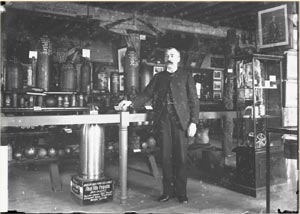
We were now marched into the office of the "Libby," where our names were registered, and descriptive lists taken. Thence we were conducted into another room upon the same floor, here we were drawn up in line and informed by a sleek, well-fed individual that if there happened to be any amongst us who [had] any "greenbacks" or "specie" it would be advisable to transfer it to his fostering care for the time being, solemnly assuring us that it would be returned to us when exchanged; in case we refused to "disgorge" however, and the forbidden treasure should be found upon our persons, it would be "confiscated." We had witnessed too much of the perfidy of the sons of the south, however, to place any reliance upon the promises of this smooth tongued gent, and resolved that if we were to be robbed, we would at least have the satisfaction of seeing it done openly.
Former prisoners of war who visited the Libby Prison War Museum were registered in a log book.

Visitors encountered a huge display of armaments when they first entered the museum through the Prisoner's Reception Room.
The Civil War has been characterized as the first modern war. Mass armies confronted each other with deadly weapons made possible by the industrial revolution, including rapid-fire carbines and Gatling machine guns. Appalling casualties necessitated a constant supply of new soldiers. Chicago became a primary provider of both men and supplies for the front. (FONER & MAHONEY 79)
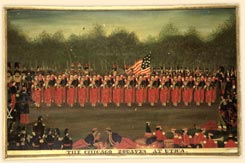
Ellsworth organized a Chicago Zouaves Cadets Drill Team that toured the country beginning in 1859, inspiring volunteer militias across the country. Ellsworth was the first Union officer killed when he tore down a Confederate flag in Alexandria, Virginia. He became a national martyr and a symbol for calling Union troops to arms.
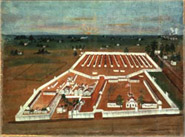

Thousands of Union recruits passed through Chicago's Camp Douglas for training before boarding trains bound for the front.
A delegation of Chicagoans visited Lincoln in February 1865 to remind the president that Cook County had provided more men for the war effort than any other district in the Union, with the exception of a county in southern Illinois. The trains returned to Chicago with thousands of Confederate soldiers beginning in 1862 when Camp Douglas became a Union prison camp. Chicago's network of railroads also provided uniforms, shoes, flags, horses, meat, and grain manufactured in the city for soldiers at the front, laying the foundation for the city's emergence as a major industrial center at the end of the war. (KARAMANSKI 225, 159-178) Artifacts at the Libby Prison War Museum included locally manufactured uniforms, shoes, and flags sent to soldiers at the front.




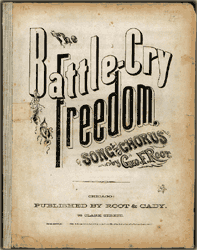
The museum featured a number of relics commemorating the life of Elmer Ellsworth, a partner in Lincoln's law firm, who rallied Chicagoans and Northerners to the slaughterhouse of civil war.
Chicagoan George Frederick Root inspired Northern troops with his "Battle Cry of Freedom," the song that became known as the Union's anthem.
Listen
to George F. Root's
BATTLE-CRY
OF FREEDOM
Choose the option below that matches your Internet connection:


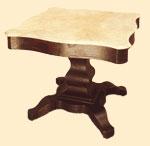



You will need QuickTime to play the music in this section. Click here to download and install QuickTime.
